#WatchGSQualiesFolks
Text

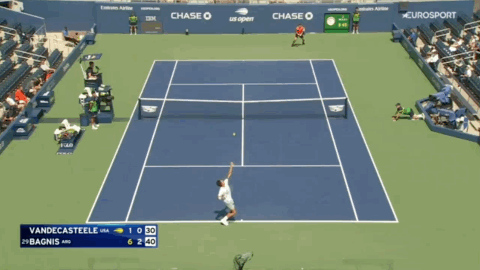
📸 🎥 Eurosport
The second set turned out to be another different set of demolition. Bagnis affirmed his level through his aggressive play, while Vandecasteele could not come up with a decent answer to Bagnis' questions. Here was how everything unfolded.
After the first game ended up with a deuce, Bagnis came up with a backhand passing shot before he broke to 1-0 at the expense of Vandecasteele's forehand rush (again). The former then consolidated the game to 2-0 before another forehand rush resulted in a break point before Bagnis' forehand winner resulted in another break of serve to 3-0. Bagnis strengthened his lead to 4-0 afterward, asserting his control even further in this match.
Somehow, Vandecasteele could only manage to hold 2 service games before Bagnis had the opportunity to serve for the match. Bar several hiccups, at the expense of Vandecasteele's forehand error, Bagnis took the second set 6-2 and became the first person to win their qualifying match of the day, securing a meeting between Felipe Meligeni R. Alves or Dalibor Svrcina in the second round.
#atp world tour#atp tour#grand slam#us open#us open tennis#tennis updates#hot shots#break point#match point#quinn vandecasteele#facundo bagnis#WatchGSQualiesFolks
2 notes
·
View notes
Text
Wimbledon MS: Draw Release + Know Your Lucky Losers

The Men’s Singles full draw (📸 Wimbledon official stream)
The Men’s Singles Draw was just concluded several minutes ago, which play begins in Monday for the bottom half alongside the Women’s Singles’ top half. While there are several vintage-coded matches also featured after the draw, several qualifiers could also be of attention (which features could be found here and here) due to how well they adapted their game to the grass courts.
After both lucky losers have been placed, for the first time, all Japanese players competing in the third qualifying round of Wimbledon (and becoming the most represented country there) scored a full slate in their main draw appearance thanks to the qualifications of Sho Shimabukuro and Shintaro Mochizuki, with Taro Daniel and Yosuke Watanuki officially joining them after being announced as the lucky losers. And now, presenting the lucky losers:
Lucky Loser 1: Yosuke Watanuki (l. Dennis Novak 7-6(9), 3-6, 3-6, 4-6)

Yosuke Watanuki’s point to *0-1 0-15, 4th set (📸 Wimbledon qualification feed)
Y. Watanuki’s ability to bother people with his rallies might be more visible once he eliminated now-retired Feliciano Lopez, followed by a thriller three-setter against Hubert Hurkacz back in Stuttgart (250). Somehow, his last two qualifying rounds in Wimbledon suggested he still kept it close against Seongchan Hong (Q1) and Altug Celikbilek (Q2), but was insufficient when he faced a more experienced Dennis Novak.
Although Y. Watanuki took the first set in a close tie-breaker, it was not enough to counter Dennis’ power and variety, which were often pulled during the rallies. He tried to pass Dennis from his forehand side (including the one to set himself ahead somewhere in the third set), but still insufficient once Dennis got in his moment, resulting in the more straight subsequent three sets compared to the intense first.
In the first round, he will face Marc-Andrea Huesler, whose form post-Australian Open had been its own rollercoaster, including a second-round exit to Rinky Hijikata in ‘s-Hertogenbosch (250) in another three-setter. Huesler had to qualify for Wimbledon last year before his five-set first-round loss against Hugo Grenier, which makes this match possibly interesting if Y. Watanuki could control the flow more.
Lucky Loser 2: Taro Daniel (l. Kimmer Coppejans 3-6, 6-4, 6-4, 4-6, 2-6)

Taro Daniel’s point to hold 4-3, 3rd set (📸 Wimbledon qualification feed)
Starting his qualifying journey by convincingly defeating Marco Trungelliti and Luca Nardi, T. Daniel faced Kimmer Coppejans, who previously eliminated Zizou Bergs in the second qualifying round. While he could still keep it competitive on the greens, notably against Tommy Paul in Queen’s Club earlier this year, the pacing to his aggression became tested in the third qualifying round.
While he was notable for some shots throughout the qualifying, for example a dive volley back in the first qualifying round, T. Daniel also scored another impeccable shot with a no-look volley to hold his service game in the third set. However, as hard as he tried to keep Coppejans’ balance off toward the end of the third set (with a forehand winner as a gate-opener, for example), it was insufficient to neuter Coppejans’ rallying since he constructed his points more systematically, hence T. Daniel had his service games pressured even more in the deciding set.
T. Daniel is set to face 32nd seed Ben Shelton in the first round, whose dynamic game can still be applicable on grass. Shelton kept it close in his last two grass-court tournaments, with his service games mostly working, and a little polishing on pace could also help. An exciting encounter is on the looks.
UPDATE: Due to Filip Krajinovic's withdrawal, there is another lucky loser in Michael Mmoh.
Lucky Loser 3: Michael Mmoh (l. Laurent Lokoli 6-2, 6-7(2), 3-6, 6-2, 2-6)

Michael Mmoh's point to break 1-0, 4th set (📸 Wimbledon qualifying feed)
Mmoh previously qualified for the Wimbledon main draw in 2018, where he had a first-round exit against Gilles Muller in a five-setter. This year, he had to go past Adrian Andreev and Dragos Nicolae Madaras in the first two rounds, where he won those first two rounds in three sets.
However, as much as he tried to attack Lokoli's baseline games, one of which came from his forehand down-the-line winner to secure the early break in the fourth set, it was insufficient to counter Lokoli's intuition. On the other hand, a reliable service game in these faster courts could carry him forward, but creating the offense could possibly be the biggest challenge when he face Felix Auger-Aliassime in the first round.
#atp world tour#atp tour#grand slam#wimbledon#wimbledon championships#wimbledon 2023#tennis updates#draw#yosuke watanuki#taro daniel#WatchGSQualiesFolks
2 notes
·
View notes
Text



📸 🎥 Wimbledon Qualifying Day One World Feed
The first day of qualifying already kicked off, which carried on with a battle between wild card Charles Broom and Alessandro Giannessi. C. Broom had an interesting run in the other grass tournaments leading up to the qualifications, going all the way to the Ilkley Challenger quarterfinals and forcing Zsombor Piros to endure a close three-set match, while Giannessi had a career win-loss of 3-7 on the grass-courts.
Initially, C. Broom had two break points to start the first set, one of which came from his forehand pass in response to Giannessi's drop shot. However, Giannessi ended up holding that service game to 1-0. Furthermore, he also survived a break exchange, especially since he trailed 1-3 and came back to 3-3 afterward.
Two consecutive holds later, C. Broom opened another opportunity to break thanks to his balanced power and shot-making. Despite Giannessi's cross-court volley foiling C. Broom's first break point, his net game did not carry enough as a volley error resulted in C. Broom's second break point prior to his smashing conversion (5-4). Subsequently, C. Broom successfully served for the first set, perfectly sealing it with an ace to take it 6-4.
#atp world tour#atp tour#grand slam#wimbledon#wimbledon championships#wimbledon 2023#tennis updates#hot shots#break point#set point#charles broom#alessandro giannessi#WatchGSQualiesFolks
2 notes
·
View notes
Text





📸 Eurosport
The second set turned out to be its own turnaround once J. Mensik's rhythm tuned in. This started when Riedi thought the net play became one of the most important key, with a volley equalizing the point after a double fault, neutralizing J. Mensik's forehands (which was a talking point throughout the game due to its role in giving Riedi more pressure) to hold his service game 1-1.
Knowing the net play, J. Mensik started to have a set of ideas, starting from pressing Riedi from the baseline. From there, apart from getting to Riedi's second serves, he foiled Riedi's game points due to the Swiss' forehand being executed too wide to close a point before a double fault resulted in J. Mensik breaking to 3-1. A failed volley in response to Riedi's preceding volley almost created a potential break-back scare before J. Mensik solidified his lead to hold 4-1.
Three games later, J. Mensik became even more creative in his point construction by pulling a drop shot to force a deuce, fumbling Riedi's game point again before the latter held to 5-3, leaving J. Mensik to serve for the second set. Compared to his inability to serve it out in the first set, he successfully did it despite several hiccups, sealing it with an ace to take the second set 6-3, ultimately forcing the match to go to the decider.
#atp world tour#atp tour#grand slam#us open#us open tennis#us open 2023#tennis updates#turning points#hot shots#break point#set point#jakub mensik#leandro riedi#WatchGSQualiesFolks
0 notes
Text

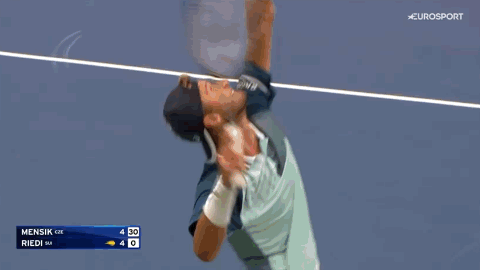
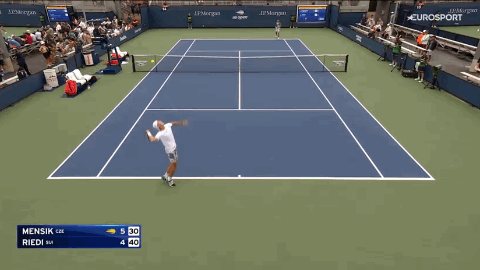


📸 Eurosport
After being rained out yesterday, one of the most interesting second qualifying round matches, which supposed to start on yesterday's third timeslot (late afternoon local time), featuring rising under-22 (NextGen) players Jakub Mensik and Leandro Riedi, finally commenced. While J. Mensik engaged in a full breadstick exchange against Fabio Fognini 1-6, 6-1, 6-1, Riedi had to dig deep to get his rhythm back when he defeated fellow NextGen Flavio Cobolli 6-1, 2-6, 7-5 in the first qualifying round. Knowing both players, return depth in general, as well as pacing in one way or another, could be one of the keys to get out of this match.
Initially, there were 5 consecutive holds (3-2, with Riedi being the latest person holding) before rain delayed play for almost 2 hours. Right when the play resumed, J. Mensik was back on serve to hold his service game 3-3. Subsequently, Riedi started to put more pressure on J. Mensik from the net, averting the damage of his own double fault with a working volley before he finally held his service game to 4-3. J. Mensik followed suit to equalize the match to 4-4.
However, Riedi's baseline shots became a talking point in the ninth game, where his forehand and backhand errors followed some double faults, one of which allowed J. Mensik to serve for the first set 5-4. It should have been done, but Riedi had ideas to press J. Mensik back from the baseline, resulting in an important break-back to 5-5. It took two consecutive holds before a tie-breaker had to determine who took the first set.
Riedi's volley became one of the biggest differentials after his service hold, leading him to take the mini-break lead to 2-0 before J. Mensik's game in the TB started to fall apart. However, when Riedi should have served for the first set at 6-2 in the tie-breaker, he had a forehand error gone too wide, which resulted in J. Mensik being back in the game, holding his service game until at least 6-5 after that point. Riedi then successfully served it out with a working volley to seal the first set 7-6(5).
#atp world tour#atp tour#grand slam#us open#us open tennis#us open 2023#tennis updates#hot shots#break point#set point#jakub mensik#leandro riedi#WatchGSQualiesFolks
0 notes
Text
US Open WS Q2: Dayana Yastremska [12] def. Eugenie Bouchard [PR] 6-1, 4-6, 6-4 Match Stats

📸 Eurosport
Interestingly, while this match looked equal based on their break point conversion rates alone, Dayana controlled the flow of most of this match. This was visible through the way she stood out, winning 30 more points as a result of capitalizing on Bouchard's frequently erratic service games, often a result of being underpowered in the critical moments. Simultaneously, Dayana was aggressive in constructing her points, where some of her winners created one of those 11 opportunities with a 36% break point conversion rate.
On the other hand, as risky as their second serves could be, Bouchard's second serves predominantly looked error-prone, in which Dayana ended up rallying from. Somehow, while both players landed 57% of their first serves, Dayana still had 15% more winning rate compared to Bouchard, especially considering her follow-up shot placements and how her rallies often ended by: Bouchard's constant misfires at times.
In tomorrow's third qualifying round, Dayana will face 17th seed Elena-Gabriela Ruse, who dug deep to defeat Dalma Galfi 4-6, 6-1, 7-5 in the second qualifying round. While power play could also be important, rally tolerance could be another aspect of attention in general while constructing their points, since one would stand out when they will be able to open their chances through their winners. Should be an interesting encounter as well!
#wta tour#wta tennis#grand slam#us open#us open tennis#us open 2023#tennis updates#match stats#dayana yastremska#eugenie bouchard#WatchGSQualiesFolks
0 notes
Text


📸 🎥 Eurosport
In the third set, Dayana’s power was too much to handle right from the setup, which turned out also explaining the first set where Bouchard was completely underpowered compared to the third. It was visible from Dayana’s pacing as well, where she continued the fifth game with a backhand return ace to set the break point before its conversion thanks to her forehand winner to 3-2. Subsequently, Dayana held her service game 4-2 without much hesitation.
Two consecutive holds later, Dayana almost doubled the break when there was a cat-and-mouse game in the seventh game thanks to a forehand winner to set one of her break points at that game, but it was foiled until Bouchard ended up holding her service game to 3-5. This led Yastremska to serve for the match, where despite several hiccups, she took the third set 6-4 at the expense of Bouchard’s forehand error, which qualified her to the third qualifying round. Understandably, the match ended up without any handshakes as a result of the Madrid controversy several months back (addressed as a general introduction to this match), and Dayana will face Elena-Gabriela Ruse in tomorrow’s third qualifying round.
#wta tour#wta tennis#grand slam#us open#us open tennis#us open 2023#tennis updates#hot shots#break point#match point#dayana yastremska#eugenie bouchard#WatchGSQualiesFolks
0 notes
Text
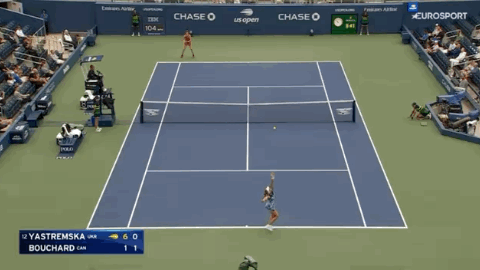




📸 Eurosport
The second set somehow had different rhythm as Bouchard’s volley touch set herself one, and even two points ahead before Dayana held that service game 1-1 by the end of that game. For some baseline reason in the eighth game, Bouchard tried to find her rhythm while aiming at Dayana’s forehands, which were visible from a forehand that was executed too wide, which was also the case 2 points later, hence Bouchard had the opportunity to serve for the second set. However, visible erratic service game, likely stemmed from tightness or insufficient power, led her to be broken back 4-5.
Bouchard did not take too long to finally break for the second set as the path already opened thanks to her forehand return ace to set her 2 set points. Even if Dayana’s forehand winner saved one of those set points, it was not enough as her netted backhand resulted in Bouchard breaking for the second set instead (6-4), leading this already dramatic match to a decider to find out the one that advanced to the third qualifying round.
#wta tour#wta tennis#grand slam#us open#us open tennis#us open 2023#tennis updates#hot shots#break point#set point#dayana yastremska#eugenie bouchard#WatchGSQualiesFolks
0 notes
Text

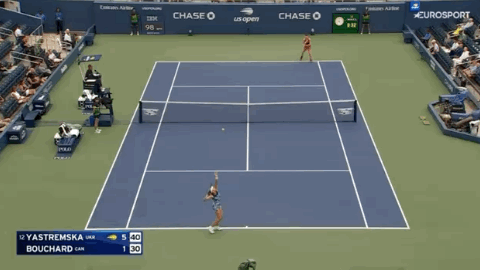
📸 Eurosport
Meanwhile, in Grandstand…
Both twelfth seed Dayana Yastremska and Eugenie Bouchard tried to regain their levels they once had, with some people notably tuning in due to the latter having a controversy back in Madrid with the former surrounding “playing dopers,” considering Dayana’s past doping suspension dated 2 years ago (when she was cleared five months after the issuance of suspension). Knowing both players’ games (and mainly desires to pick up where they left off, mainly the latter), while power could also be important, aggression would be another. Starting the first set, here was how everything unfolded.
The first set started with 3 consecutive holds, when both players had their chances to break but foiled over such service game holds. It all came down to Dayana’s proper balance of power, where her forehand winners struck Bouchard as one of them resulted in her second break point before its conversion at the expense of Bouchard’s error. Dayana then survived a lot of deuces out of some errors, even another break point before she finally held her service game to 4-1. It was a statement start from Dayana, especially with her full-scale aggression as such.
However, Bouchard’s erratic service game resulted in her being down a double break (1-5), allowing Dayana to serve for the first set breadstick. Bar several hiccups, including being 2 points down midway, Dayana successfully took the first set 6-1 after a successful serve+1, where on paper, one more set would be necessary for her to advance to the next round.
#wta tour#wta tennis#grand slam#us open#us open tennis#us open 2023#tennis updates#hot shots#break point#set point#dayana yastremska#eugenie bouchard#WatchGSQualiesFolks
0 notes
Text
US Open MS Q2: Otto Virtanen [28] def. Michael Zheng [WC] 6-1, 3-6, 6-3 Match Stats
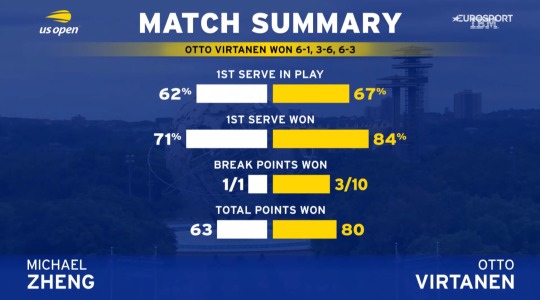
📸 Eurosport
It turned out that the flow of this match was in Virtanen’s racquet, bar the ending of the second set where his errors led to Michael successfully serving for the second set, but the moment did not last long as Virtanen regained his aggressive pace and stayed ahead right after he broke for the first time in that set. In this regard, even if Michael had a 100% break point conversion rate, Virtanen still had 10 chances to break with 30% of them being converted in the first and third sets, the former at the expense of Michael’s erratic service game as well.
On the other hand, not a lot separated both players’ first serves, but likely the second serves instead. Virtanen put 67% of his first serves in, and stood out there by winning 84% of his points than Michael’s 71%. However, Michael’s service games were rather risky (and shaky at times), where it appeared Virtanen took a lot of advantage from throughout the matches, which resulted in the former’s frequent follow-up errors when he got pressed, mainly from the baseline.
In the third qualifying round, Virtanen will face Juncheng (Jerry) Shang, who almost simultaneously defeated Patrick Kypson 6-4, 7-6(2) in a close encounter. While both players also known to have their own power, balance, either from the baseline or the net, would be the most important element in the match. It would be all or nothing, and that would mean to stand out, they need to ensure the accuracy and depth of their shots (which is rather theoretical than practical), as well as to keep their aggression stable during the rallies. Regardless of the outcome, this should be one of the matches to watch in the third qualifying round!
#atp world tour#atp tour#grand slam#us open#us open tennis#us open 2023#tennis updates#match stats#michael zheng#otto virtanen#WatchGSQualiesFolks
0 notes
Text


📸 🎥 Eurosport
By the beginning of the third set, it turned out that everything was according to Virtanen’s racquets, since he was supposed to drive the flow, but not necessarily considering the second set dip. He managed to bounce back after holding his service game, with his backhand winner once again carrying it to create a break point before Michael’s error eventually resulted in the early break to 2-0. Virtanen then strengthened his lead with a service game hold to 3-0, which was a quick hold in itself. Several games later, during Michael’s theoretical one-last stand, where Virtanen’s swift forehand return almost broke him for the match, but it did not happen as Michael held that service game 3-5 after saving those match points.
As a result, Virtanen had to serve for the match. By holding to 15, his forehand winner opened the path to the match point creation before his reflexive volley right at match point in response to Michael’s forehand resulted in his match point conversion, taking the third set 6-3 to secure another appearance in the third qualifying round (after this year’s Wimbledon), setting an exciting encounter against Juncheng (Jerry) Shang for a spot in the main draw.
#atp world tour#atp tour#grand slam#us open#us open tennis#us open 2023#tennis updates#hot shots#break point#match point#michael zheng#otto virtanen#WatchGSQualiesFolks
0 notes
Text
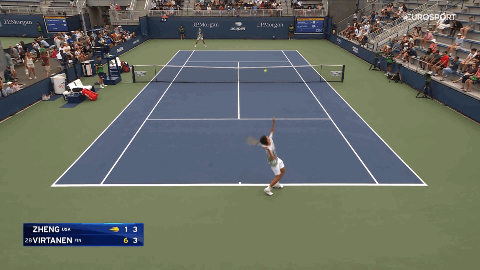


📸 Eurosport
Michael then tried to adjust his pace in the second set, where he survived a break point out of his own error and held his service game 1-0, right at this set’s start. Five consecutive holds later, Virtanen had his chances thanks to his trademark backhand down-the-line winner to open the path, setting himself a point ahead before his swift return resulted in a break point creation. However, Michael ended up saving all of those break points, and it turned out to be an important hold (4-3).
Subsequently, Virtanen was supposed to hold when he had a game point. However, Michael started to have ideas at the expense of Virtanen’s 4 continuous unforced errors, mostly from his forehand side. One that ended up being stuck to the net broke his service game to 3-5, where Michael had the opportunity to serve for the second set. Without any further ado, Michael held to 0 and took the second set 6-3, bringing the match to the decider once again. The question then shifted to Virtanen’s ability to stay in his moment, as well as if Michael ended up turning things around thanks to maintaining his rhythm from the second set.
#atp world tour#atp tour#grand slam#us open#us open tennis#us open 2023#tennis updates#hot shots#break point#set point#michael zheng#otto virtanen#WatchGSQualiesFolks
0 notes
Text



📸 Eurosport
Meanwhile, in the Flushing Meadows (New York)…
A lot of matches were played simultaneously, where they started one hour earlier than usual in a probable anticipation to incremental weather which likely would happen between the next two days (today and tomorrow local time, to be more specific). One of the most interesting matches of the day had wild card Michael Zheng, who was the Palmas del Mar Challenger runner-up (to Kei Nishikori) getting the 28th seed Otto Virtanen in the second round, the latter who went to a scenic route to defeat Emilio Gomez 1-6, 6-2, 6-3 coming back from a break down in the second set. Knowing both players’ explosive game when they are on, it completely boiled down to their execution, as well as pacing in one way or another.
The first set looked convincing for Virtanen as after holding his service game to 1-0, he tried to exploit Michael’s attempts to paint the lines until it foiled his own game point. Somehow, Michael “laid down” to reply a lower ball from Virtanen, which was succeeded by the latter’s forehand winner, earning Michael’s commendation for the break point. It did not take long until Michael’s cross-court forehand error resulted in Virtanen’s break of serve to 2-0. Virtanen then followed up with a service game consolidation to 3-0.
Three games later, Michael’s erratic service game resulted in a ton of rushed forehands, where they ended up being too wide or netted, the latter (as a result of taking it too low) resulted in Virtanen doubling the break to 5-1. Virtanen then had the opportunity to serve the first set breadstick, where, despite some stiff opposition from the baseline, resulted in the successful bakery, taking the first set 6-1 to assert his dominance. This then raised questions on Michael’s ability to keep up with Virtanen’s pace, while taking into account his usual slow start in some occasions.
#atp world tour#atp tour#grand slam#us open#us open tennis#us open 2023#tennis updates#hot shots#break point#set point#michael zheng#otto virtanen#WatchGSQualiesFolks
0 notes
Text
US Open MS Q1: Jesper de Jong def. Tristan Boyer [WC] 6-3, 6-3 Match Stats

📸 Eurosport
Boyer tried to come back, especially in the first set when there was a bigger chance to turn it around, but the pace was not there in his case. His 100% break point conversion came from the concerned set, specifically in the early parts and when de Jong should have served for it. However, the latter’s baseline game was more stable, resulting in Boyer’s forehand side often getting off balance in the critical points. De Jong then had the opportunity to unleash some winners, even opening his chances through it, hence his 8 opportunities to break as a result, as well as winning 12 more points than Boyer.
Service game-wise, Boyer landed 59% of his first serves, 1% more than de Jong. However, as vulnerable as his second serves sounded (with several follow-ups ended up in errors), de Jong still stood out by winning 23% more points from his first serves than Boyer. For the context of this match, this showed how first serves were also integral in shaping the important points, while the second serves were also important in terms of how they controlled their follow-up shots from and its outcome, where pacing (on return) was brought to the discourse as the match went on.
Liam Broady awaits in the second qualifying round as he defeated Jelle Sels 4-6, 6-1, 6-2 in a dominant fashion for the last two sets despite whatever happened in the first set. Knowing Liam’s occasionally working aggressive game when he is on, pacing would also be a tricky issue for both de Jong and Liam, but whoever got the hang out of the rhythm, they would end up being in control of the game, especially from the way they controlled the rallies from the baseline and/or their willingness to move forward and volley their way out accurately. Recognizing both players’ recent forms as well with Liam’s Winnipeg Challenger semifinal run as well last week, this should be one of the matches worth watching/following, considering all the packed qualifying actions tomorrow!
#atp world tour#atp tour#grand slam#us open#us open tennis#us open 2023#tennis updates#match stats#jesper de jong#tristan boyer#WatchGSQualiesFolks
0 notes
Text

📸 🎥 Eurosport
De Jong continued his pacing in the second set, appearing to be in control even if Boyer tried to maintain his balance. After five consecutive service game holds, de Jong successfully pressed Boyer’s serves early in the sixth game, causing the latter to err a lot of his final forehands when closing the rallies. Somehow, a forehand that went up in the air resulted in de Jong’s break point, that even if it was saved, Boyer ended up getting broken thanks to de Jong’s careful forehand winner, to the former’s dismay, who ended up getting a warning due to him breaking his racquet after that break to express his disappointment. De Jong ended up holding his service game 5-2 afterward.
Two games later, de Jong had the opportunity to serve for the match. Despite Boyer’s stiff opposition, hanging in from the baseline, it was insufficient due to de Jong’s unreturned serve to create the match point, with its conversion coming at the expense of Boyer’s forehand error, which went too wide in execution with an intention of finishing the rally down the line, securing de Jong’s second set 6-3, as well as de Jong’s second-round berth.
#atp world tour#atp tour#grand slam#us open#us open tennis#us open 2023#tennis updates#hot shots#break point#match point#jesper de jong#tristan boyer#WatchGSQualiesFolks
0 notes
Text


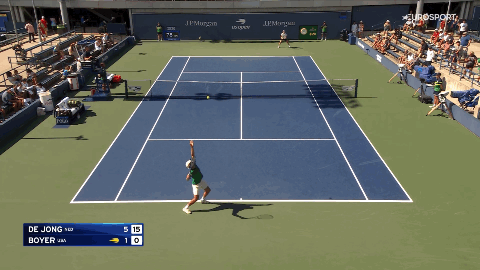


📸 Eurosport
With plethora of simultaneous actions unfolding, another interesting action of attention took place in the US Open qualifying rounds, with a first-qualifying-round match between Jesper de Jong, who just won last week’s Grodzisk Mazowiecki/Kozerki Challenger, took on Tristan Boyer, who was also a Stanford Challenger semifinalist, also in the last week. Knowing both players’ current form, it would be interesting to check on who would emerge victorious in this match, with de Jong passing his way back and forth while Boyer was also solid last week, except his inability to serve for the match resulted in Emilio Nava’s comeback win in the concerned Stanford Challenger semifinal match.
It turned out that pacing became a critical issue as this set went by. This match started with 3 consecutive breaks, with the latest happened at the expense of Boyer’s forehand rushes, followed by de Jong’s ability to hold his service game 3-1 afterward after surviving a cross-court forehand that went too wide in the point before. Somehow, de Jong found himself doubling the break at the expense of Boyer’s forehand errors, and even if Boyer had a remarkable volley to minimize the gap, de Jong held that service game to 5-1. Boyer followed by holding his service game 5-2 after surviving a likely breadstick, where de Jong opened his path through a volley and a forehand down-the-line return ace, hence the latter had to serve for the first set.
However, tables almost turned where Boyer’s forehand winner resulted in a break point before de Jong’s forehand error, which netted, resulted in the break of serve to 3-5. Theoretically, Boyer could have held that service game, only for him to have an erratic service game before another rounds of forehand errors resulted in de Jong breaking for the first set 6-3. This further strengthened de Jong’s statement that he could still able to qualify after winning a Challenger tournament the week prior, only if he also took the second set.
#atp world tour#atp tour#grand slam#us open#us open tennis#us open 2023#tennis updates#hot shots#break point#set point#jesper de jong#tristan boyer#WatchGSQualiesFolks
0 notes